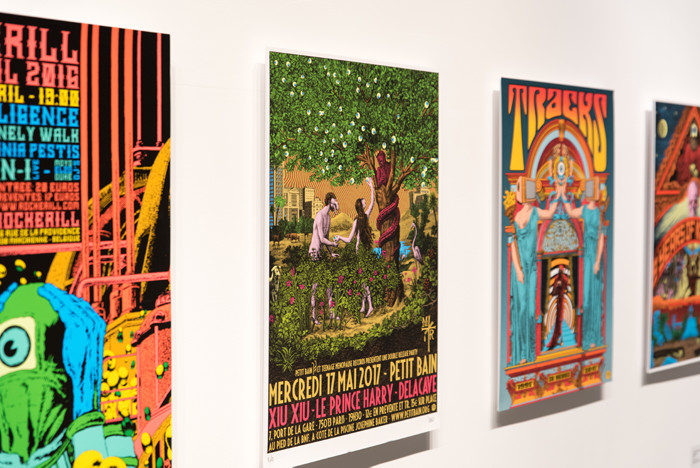Professor and curator Marc H. Choko’s exhibition, Nonconforming Poster Designers, displayed at the University of Quebec in Montreal (UQÀM) Center of Design, is a psychedelic trip without the kool-aid. The show explores the work of two classically trained designers, Elzo Durt and Sebastien Lépine, and their experimental techniques and kaleidoscopic visual effects. Durt and Lépine disregard traditional boundaries of line, form, and color in a series of silk screen printed posters reminiscent of a visual hybrid, somewhere between the Merry Prankster’s day-glo bus paintings, and the meticulous detailing of a 17th century woodcut engraving.
The exhibition is a product of curator Choko’s long-time passion for collecting posters, and focuses on the inability to perfectly reproduce a poster. While printed graphics denote endless print copies of a given image, Durt and Lépine state that they belong to a movement of poster artists that perform their own printing, rather than outsourcing, resulting in a more intimate process and limited supply of silkscreen copies. Fitting with the exhibition’s emphasis on ‘non conformity’, where reproducibility suggests common consumption, the finite supply of prints and their unique visual quality ensure that Durt and Lépine do not produce work to fulfill a commercial quota, but rather, for the sake of making art. The show highlights the intersection of visual and musical worlds; Durt and Lépine build on the motifs of past decades and the pre-existing graphics of production companies and bands in a way that integrates the past and present, the original and the reproduced.
Durt’s oeuvre employs an unconventional approach to collage work, using various ‘borrowings’, which include references to counterculture movements such as the sexual revolution and summer of love, popular culture, and borrowed imagery to inform a body of work that is both psychologically and visually engaging. Beyond their aesthetic appeal, his works function as graphic narratives, with their seemingly endless arrangement of patterns, images of loose body-parts, and juxtaposition of the organic and man-made. Durt’s work, which generally takes the form of music festival posters, album covers, and logo design for various companies, is internationally recognized, and can be seen in the vacant, yet alluring, gaze of the woman on La Femme’s Psycho Tropical Berlin, or in a skateboard design collaboration with Belgium-based company, Antiz. Durt’s designs are simultaneously comical and abject—in one print Adam and Eve-like figures consume eyeballs from the tree of life, in another classical Greek women have televisions for heads.
In the same way that contemporary and historical artists, such as Rembrandt or Van Gogh, use under-paintings, or careful layers of color to build a rich and textured surface, Sebastien Lépine’s designs are often layered, performed for what he describes as “a quest for depth”. While this means that some elements are obscured, Lépine’s unique technique allows him to establish a feeling of narrative through process, suggesting the passing of time or a multiplicity of experiences within a single frame. Lépine uses his posters to combine his passions for music and art, reworking album covers and the graphic designs associated with bands such as Beach House, Father John Misty, and Cigarettes After Sex.
In a contemporary culture that is increasingly informed by the past—whether through high waisted jeans and white sneakers, or the recent resurgence of vinyl—Durt and Lépine revive elements of classic psychedelic design and music in a way that pulls you to the past and back again with your favorite indie classics made new.
Nonconforming Poster Designers is located in the UQAM Center of Design and will remain free and open to the public until Sept. 23.









